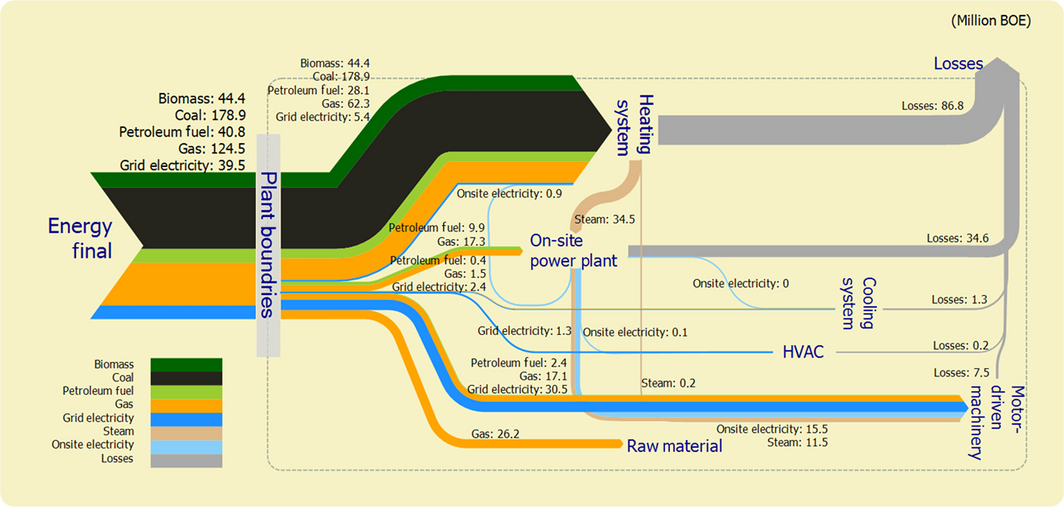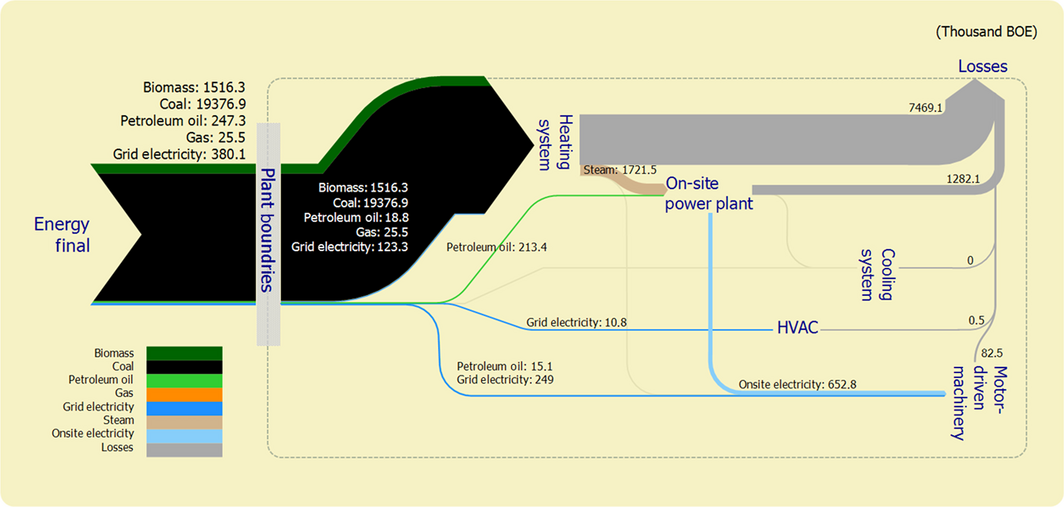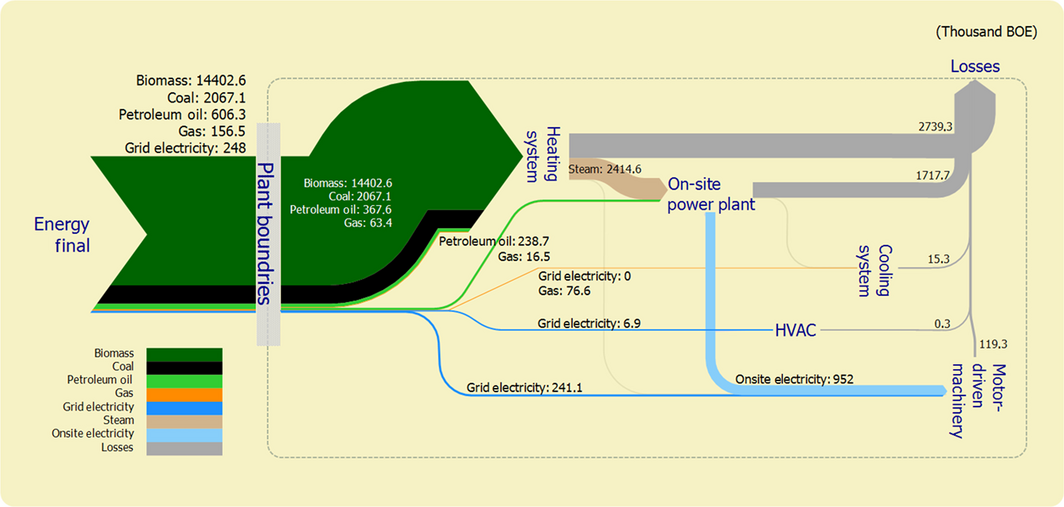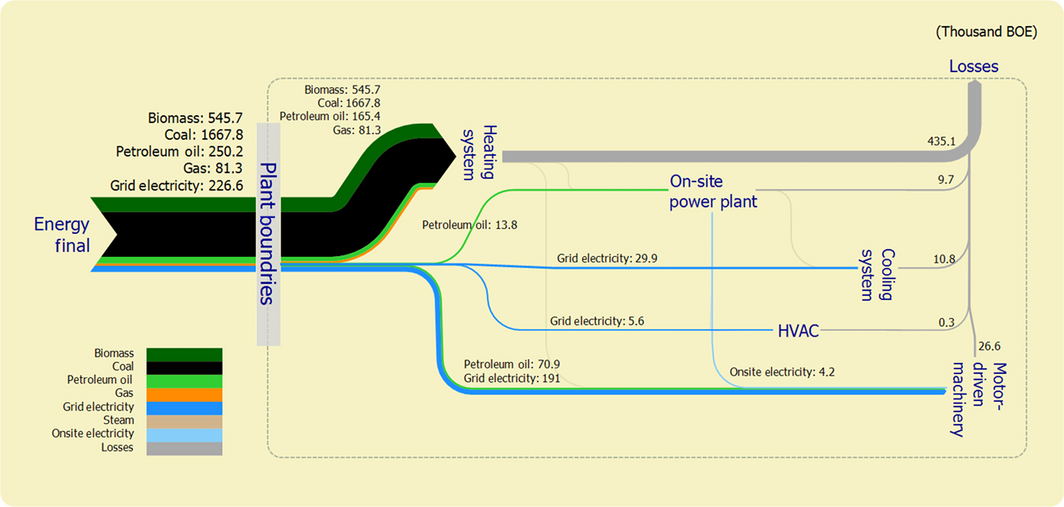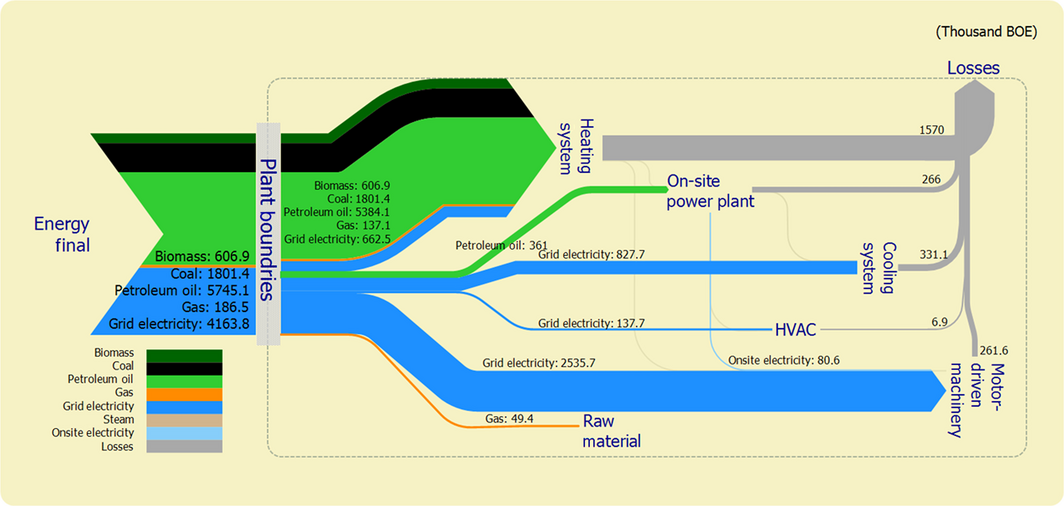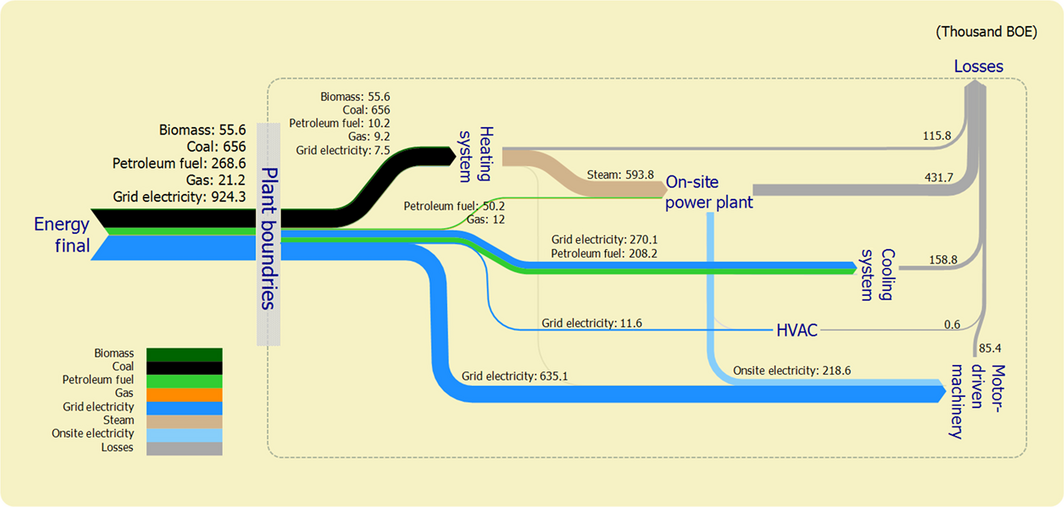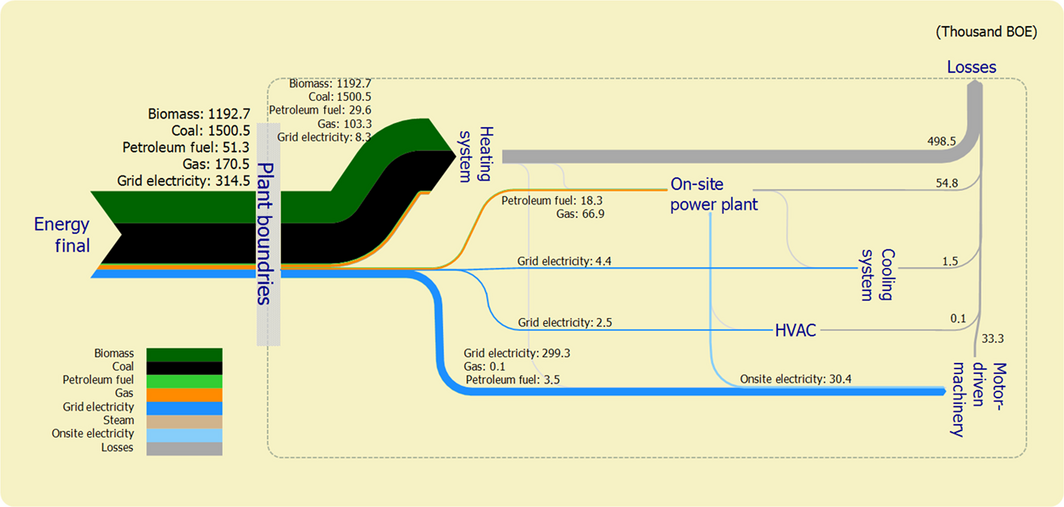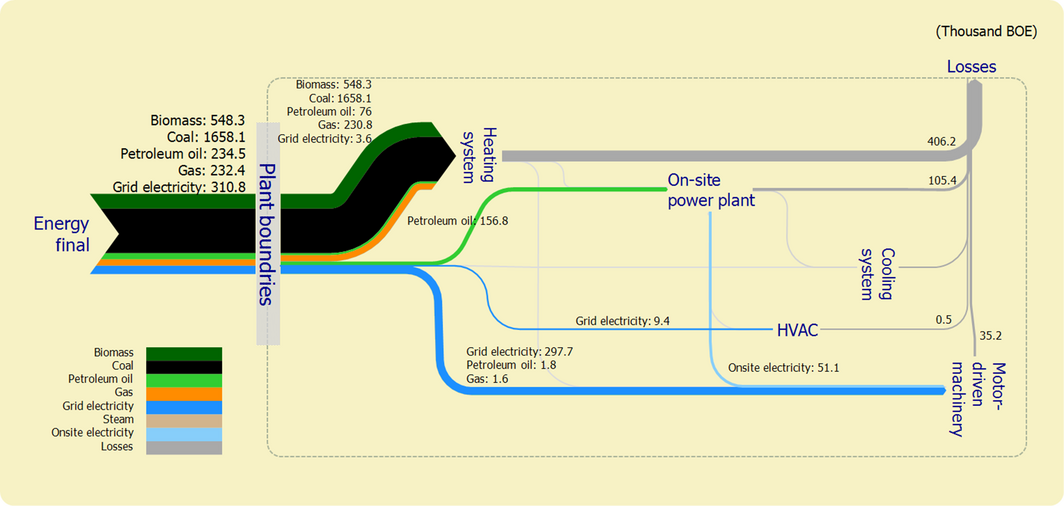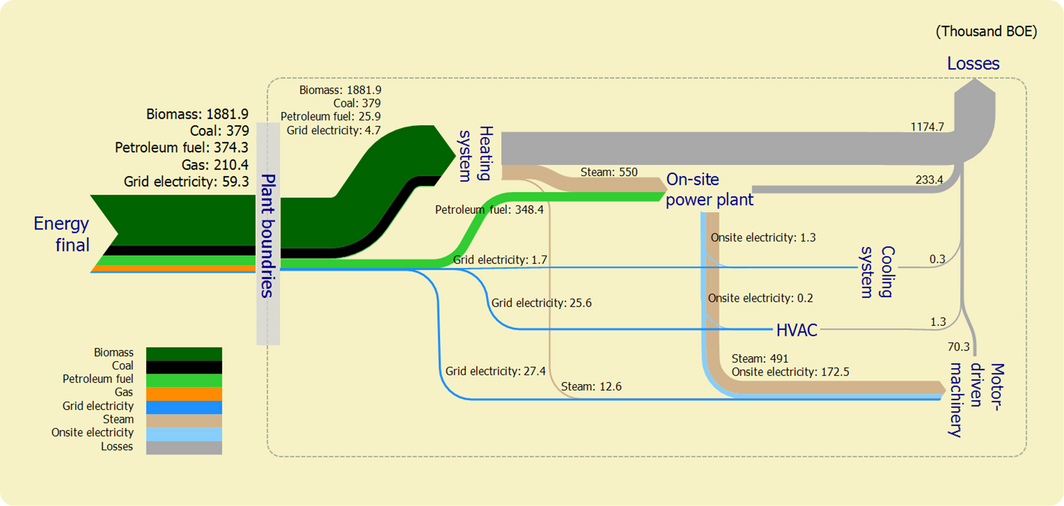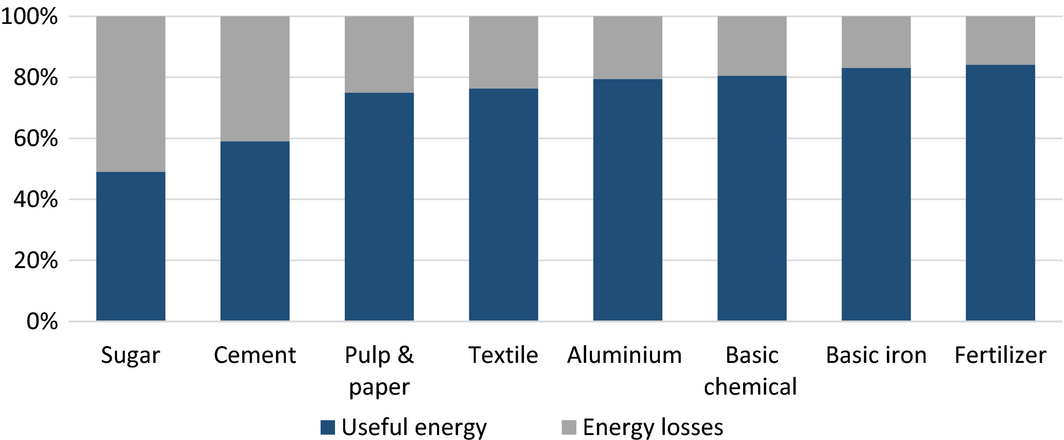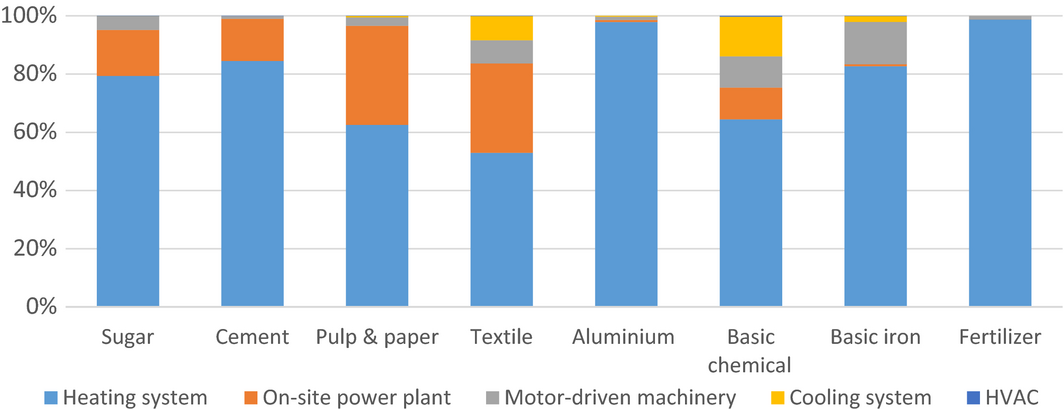Abstract
The low energy efficiency is the source of the large energy consumption issue and the rapid growth of energy demand in the manufacturing industry sector in Indonesia. The driving forces behind the low energy efficiency situation in this sector are both economic and efficiency factors. The objective of this study is to generate the map of the energy flow in the manufacturing industry sector to investigate the energy utilization in the industrial process. The data sample that represents 80% of energy consumption in the manufacturing sector is used to generate this map. The generated map shows the heating system is the largest energy consumer among all energy equipment and as the primary source of the energy losses. Additionally, we found the industry groups such as sugar, cement, pulp and paper, and textile use enormous amounts of energy as their source for the heating system; meanwhile, the industries such as basic chemical, metal, and textile are the largest electricity consumers for their motor-driven machinery. The energy flow analysis together with the comparison of the Specific Energy Consumption shows the areas that should be the focus for further energy conservation measures. Recommended measures are also discussed.
Introduction
Improving energy efficiency is the most important first step toward achieving the three goals of efficient energy policy: security of supply, environmental protection, and economic growth [1]. To improve energy efficiency at the national level in Indonesia, the effort should be focusing on the manufacturing and transportation sectors. Both sectors are consuming more than 60% of the total energy supply, and the yearly average demand growth of the manufacturing sector during 2009–2013 is 9.0% [2]. This growth rate is almost double compared with the yearly average growth rate of the total energy demand, which is only at 5.3% during the same period. While at the same time, the contribution of manufacturing sector to gross domestic product (GDP) declined from 21.6% in 2010 down to 20.8% in 2013 [3].
Similar to those in many other countries during the period of 2000–2013, Indonesias energy intensity also declined during this period. However, compared with other developing countries such as China, the decline rate of Indonesian energy intensity in the last 5-year period (2009–2013) was much lower. The yearly average decline rate of energy intensity in China was 9%, while Indonesian yearly average decline rates were only 4%. Even though the yearly average demand growth of energy in China during the above-mentioned period was 5.6% or slightly higher than Indonesias energy growth rates (5.3%), China has successfully decreased the yearly average energy consumption from 10.5% during 2003–2008 to 5.6% during 2009–2013. The government policy on the export tax plays a significant role in this reduction [4]. At the same time, Indonesian yearly average energy demand growth was increasing from 2.6% during 2005–2009 to 5.3% during 2009–2013, where the total energy demand Indonesia in 2013 was 1.2 billion Barrel Oil Equivalent (BOE) [5]. These observations clearly indicate that both energy consumption and energy efficiency are among the main factors that have brought the energy intensity of the manufacturing sector to the higher level.
The Competitive Industrial Performance (CIP) index in 2013 that issued by United Nation Industrial Development Organization (UNIDO) [6] shows Indonesian industry is ranked at 38. This position is much lower compared to the neighboring countries such as Thailand, Malaysia, Singapore, and China that are at rank 6–23. The CIP index is a composite index that measures the ability of the countries to produce and export manufactured goods competitively. The CIP index consists of eight subindicators grouped along three dimensions of the industrial competitiveness in which the level of technological deepening and upgrading of the countries is one of the three dimensions of competitiveness. This report demonstrates the contribution of high technology manufacturers among Indonesian manufacturers is the lowest among all above-mentioned countries. As a result, this technological aspect affects the level of energy consumption as well as the energy efficiency. The typical energy utilization of each industry is so much affected by the various conditions besides the technology aspect such as the scale of the manufacturing plant, and the type of the industry. This study is only focused on the large and medium scale of industries according to the four-digit classification of International Standard of Industry Classification (ISIC) category that assumes the member in each industry group is relatively comparable.
The studies on the energy demand side of the manufacturing sector in Indonesia are very rare. Irawan et al. [7] studied the energy demand of manufacturing sectors between 2002 and 2006. This study used a top-down approach of both Laspeyres index decompositions and Panel Data Analysis that explained the driving force of the changes in energy intensity in 2002 and 2006 was both structural effects and efficiency-related effects. The report from Pambudi [8] on his study of the energy intensity of the medium and large industry has also indicated the similar issue. However, both studies did not explain the driving forces behind the inefficiency and left further questions, such as whether the low efficiency of the industry is related to the type of industry and the energy utilization of energy equipment in the manufacturing plant. Another study of the energy consumption in the manufacturing sector has been reported by Sitompul in 2006 [9]. The report has indicated the industry such as textile, chemical, and paper should be the major priority for energy efficiency improvements by adopting the energy efficient technologies. This study also did not elaborate which part of the production equipment should be improved.
There are also not many studies about the energy flow mapping. The report from Cullen and Allwood [10] is among the very rare studies. This study suggests the investigation of the global improvement of energy efficiency measures that require tracing of the energy flow along energy value chains. Another study on this subject has been reported by the Energy Efficiency and Renewable Energy (EERE) of the US Department of Energy (DOE). The report of energy flow map was published by EERE in 2012 and called as the energy footprints [11]. This map shows the flows of various types of energy inside an industrial plant consisting of three areas: on-site power generation facility, process purpose, and non-process purpose equipments. The energy footprints produced for industry sector help to see the specific area for potential efficiency improvements and the achievable energy savings. Chen et al. [12] used the energy flow analysis to identify energy use of the pulp and paper industry in Taiwan. This study reported that energy flow analysis has helped to find out the main reasons for energy loss were the internal distribution, boilers, electricity generation, and process equipment inefficiencies. Ferng [13] proposes a calculation framework to estimate energy footprints according to the primary energies embodied in the goods and services consumed by a defined human population and develop scenarios and simulation of policy instruments for reducing energy footprints in Taiwan. Dacombe et al. [14] also showed that the energy footprint approach could identify the major source of energy saving to determine the best options for the waste glass recovery from households.
Another method to identify the potential energy efficiency is by comparing Specific Energy Consumption (SEC). The SEC comparison between the industry sectors with the best practice reference of the similar industry will provide a better understanding of energy efficiency of the above industry.
Among the reports of energy flow study, the study on energy flow mapping of the manufacturing industry and combined with the SEC analysis in the developing countries such as Indonesia has not been reported. To fill in the research gap, the main objective of the study is to generate the map of the energy flow of the manufacturing industry which falls under the category of the medium- and large-scale industry in Indonesia and the SEC analysis for each industry group that considered as the largest energy consumer. These maps can reveal how the industry utilizes and consumes a large amount of energy and guide the measures for improving energy efficiency.
Methodology
In this study, the bottom-up approach was adopted to generate the map of the energy flow in the manufacturing industry of Indonesia. The main challenge in this study is the data availability limitation to construct the energy flow diagram. To overcome this limitation, we collected the site data from 40 industry groups that represent 80% of the total energy consumption in the manufacturing industry. Indonesian manufacturing sector in 2013 consisted of approximately 25,000 industries, which could be divided into 177 industry groups based on ISIC version 4.0. This classification is basically based on the similarity of the industry. The total industry population of these 40 industry groups is approximately 9800 industries where the industry population of each industry group is ranging from 16 to 1485 industries. The target sample of each industry group has been selected randomly using the purposive sampling criteria to ensure that the selected samples will represent the average energy consumption profile of each industry group. The size of the sample is circa 4% of the industry population of each industry group. The total collected samples are 375 industry samples out of 9800 industry populations, representing almost 4% of the target industry populations.
The data collection and site visit have successfully managed to collect the energy consumption data, such as types of energy, demand profiles, energy use, and the historical production data. The collected information shows the manufacturing plant purchases, the various types of energy at the market prices that consist of petroleum fuels, coal, natural gas, biomass, and the grid electricity from outside providers. Bhattachariyya et al. [15] have identified that the bottom-up models are traditionally based on a detailed representation of the end-use energies such as heating, lighting, mechanical energy, and process heat. This study refers to the above classification and combines it with the type of final energy used. The types of energy equipment used in this study are grouped into six categories consisting of heating system, cooling system, motor driven machinery, on-site power plant, Heating, Ventilation and Air Conditioning (HVAC), and the energy source for raw materials.
The above energy utilization data of each industry group only represent the typical energy consumption and utilization of the specific industry group and does not represent all the industry group. This data were then plotted as the energy flow diagram for each industry group. The combination of the energy flow diagram of each industry group will construct the energy flow diagram that explains the energy utilization in the overall manufacturing sector. Finally, the data of the total energy consumption in the manufacturing sector published by the Ministry of Energy and Mineral Resources (MEMR) [5] are applied into this energy flow diagram to obtain the quantity and the utilization of each type of final energy by the energy equipment of the manufacturing industry in 2013.
The energy flow diagram in this study is represented by the Sankey diagram, first introduced by Riall Sankey in 1898 [10]. This diagram shows the chain of the energy flow where the quantity of energy traced through the manufacturing plant facilities was represented by arrows or lines, in which the width of lines or arrows represents the volume of energy flow. The diagram provides the visual comparative scale of the energy flows in which the dominant energy flow can be quickly identified. The energy supply from an outside manufacturing plant is represented by five different colors of arrows where each color represents one type of final energy.
This study also analyzes the typical Specific Energy Consumption (SEC) of the large energy consumer industry. The total energy consumption divided by the total production of the plant provides the SEC ratio that can give the total energy consumed to produce one unit of product. Then, the SEC of the target industry is compared with the best practice of the SEC from other parts of the world. The comparison analysis of SEC only applied to the industry with large energy consumption such as pulp and paper, chemical, textile, basic metal and steel, and sugar processing. This comparison will give the potential energy saving that could be achieved by the industry.
Results and Discussion
Distribution of energy utilization
The overall energy flow in the manufacturing industry in Indonesia is shown in Figure 1. The energy flow diagram shows that coal and gas are the largest final energy supplier in the manufacturing industry. The contribution of coal and gas to the total energy supply is 42% and 29%, respectively. The remaining 29% of the demand is supplied by the other types of energy such as biomass, petroleum fuel, and grid electricity.
|
|
|
Figure 1. Energy flows of the manufacturing industry sector. |
The heating system is the largest energy equipment sector in which the main energy suppliers are coal and biomass. Coal and biomass exclusively used by the heating system where the heat output of the heating system utilized by various production equipment such as on-site power plants and the motor-driven machinery.
Motor-driven machinery is the largest energy equipment after the heating system. The motor-driven machinery utilizes almost 78% of the grid electricity supply on the top of the electricity generated by the on-site power plant. The grid electricity supplies 60% of the total final energy demand of motor-driven machinery, while the remaining demand is supplied by petroleum fuel and gas. The motor-driven machinery also gets the energy input from the internal supply such as steam from the heating system and electricity from on-site power plants. The internal energy supply has provided approximately 33% of the total energy demand of this energy equipment. The composition of the final energy utilization shows that the motor-driven machinery relies much on the grid electricity supply.
Energy use for the on-site power plant is sitting on the third highest position among the energy equipment after the heating system, and motor-driven machinery. The energy input for the on-site power plant comes from petroleum fuel, natural gas, and the steam from the heating system. The steam supply from heating system is approximately 56% of the total energy demand of on-site power plant and the remaining energy demand is supplied by natural gas and petroleum fuel.
The use of final energy for the feedstock of the production process, cooling system, and HVAC are among the lowest energy equipment in the manufacturing plant. The utilization of the final energy for the raw material purposes was dominated by natural gas for the fertilizer industry. The total volume was only 6% of the total energy supply or equal to 21% of the total gas supply to the manufacturing industry. The energy utilization for the cooling system, and HVAC was even lower at 1% and less than 0.1%, respectively.
Energy utilization of the selected industry group
The top-down analysis by Irawan et al. [7] has indicated that the efficiency-related factor is the key driving force of the energy intensity issue and Sitompul [9] has also reported that the industries such as textile, pulp and paper, and basic chemical are among the priority for adopting energy efficiency technologies. This section will show the typical energy flow and the energy utilization of the large energy users mentioned above.
The cement industry is the largest energy users in the manufacturing sector in Indonesia. Figure 2 shows the energy flows of this industry. The energy input is dominated by coal that supplies almost 90% of the total energy supply and left only 10% of demand to be shared by other types of energy. The heating system in cement plant only uses coal and biomass as the main energy supplier, while the prime mover of the motor-driven machinery gets the energy supply from the grid electricity. The grid electricity supply is only 18% of the total electricity supply where most of the electricity supply comes from the on-site power plant that used the excess steam from the heating system process. The energy losses of this industry are relatively high or approximately 42% of the total energy input. Most of the energy losses produced by the waste heat of the heating system process where only 23% of the waste heat that used back by the prime mover of the power plant.
|
|
|
Figure 2. Energy flows of the cement industry. |
The huge coal consumption for cement production in Indonesia basically shows the typical characteristic of cement industry that is dominated by massive kiln technology in their production process in which some of them are still using wet process technology. Unfortunately, the huge amount of waste heat is still underutilized which potentially can be used for further energy conservation.
Pulp and paper industry (see Figs. 3 and 4) consist of two major branches: the pulp industry and paper manufacturing industry. The energy supply for the pulp industry mostly comes from the excess wood of the pulp production process with a small amount of additional energy sources such as coal, oil, natural gas, and grid electricity. The grid electricity only supplies 20% of the total electricity load where 80% of the load is satisfied by the on-site power plant that uses almost half of the excess heat from the heating system process. Reutilization of excess heat has reduced the total energy loss of this industry group down to 16% of total energy input.
|
|
|
Figure 3. Energy flows of the pulp industry. |
|
|
|
Figure 4. Energy flows of the paper industry. |
The energy supply for paper industry group is dominated by coal that supplies 60% of the demand and followed by other types of energy. The heating system utilizes 90% of energy inputs and consists of all energy types except grid electricity. The grid electricity mostly supplies the motor-driven machinery beside the cooling system and HVAC. The paper industry group clearly relies much on the grid electricity supply as compared to the pulp industry. Total energy loss from this industry group is approximately 17% and mostly come from the heating system process. The energy loss from the heating system alone is approximately 18% of the total energy input on this process or higher compared with the energy loss from the heating system of the pulp industry.
The large energy consumption for pulp and paper industry is basically dominated by the pulp industry instead of the paper industry. The pulping process is the most energy-consuming phase in the entire production process of the paper manufacture. The availability of the biomass with low handling cost is the solution for this high energy consumption process. The availability of biomass with low handling cost has put less pressure on the energy conservation issue in the pulp industry. The paper industry as the downstream industry uses less biomass compared to the pulp industry except for the paper industry that integrated with the pulp industry. The paper industry that located away from the pulp industry uses more coal instead of biomass and also the significant user of grid electricity. The availability of the biomass and high handling cost compared to coal are among the main reason why the utilization of biomass is much lesser than the pulp industry.
Energy supply for the basic chemical industry is dominated by petroleum fuel and the grid electricity as shown in Figure 5, where the petroleum fuel supply is approximately 46%, grid electricity supply is 33%, and coal is only 14%. Almost 70% of the energy supplied converted into heat and even 16% of the grid electricity supply also goes to the heating system. Most of the petroleum fuels are used for the heating system, and only <10% goes to the on-site power plant. The on-site power plant in this industry group mostly uses petroleum fuel instead of other types of energy. The utilization of excess steam from the heating system process is also less utilized to produce other forms of energy such as electricity.
|
|
|
Figure 5. Energy flows of the basic chemical industry. |
The basic chemical industry is the largest grid electricity consumer in the manufacturing industry sector. Its electricity demand is approximately 4% of the total supply of grid electricity devoted to the manufacturing industry sector. The supply of grid electricity is mostly used by the motor-driven machinery and followed by the cooling system. The technical requirement of the production process has forced this industry group to consume a large amount of grid electricity. Unfortunately, the contribution of the on-site power plant to the motor-driven machinery is only less than 3% compared to the supply from grid electricity supply and almost no supply from the on-site power plant to the cooling system. The petroleum fuel supply is approximately 46%, the grid electricity supply is approximately 34%, and coal is only 15%. Almost 68% of the energy supply converted into heat, and 16% of the grid electricity supply goes to the heating system. The estimated energy loss of this industry group is approximately 19% of the total energy input where the heating system contribution is approximately 64%.
The single largest electricity grid user in Indonesia is a petrochemical plant that uses the electricity on its electrolysis process and motor-driven machinery. Some of the members in this industry group also use the grid electricity supply on the heating process in very substantial quantity for the technical requirement reason.
The textile industry is divided into three major branches: the spinning industry, weaving industry, and textile finishing industry. Figures 6-8 show the energy flow of each industry in the textile industry group. The energy demand behaviors of these three subsectors of the textile industry reflect the production process of each industry group. The weaving industry and finishing industry are the first and the second largest energy users and the consumption of coal and biomass could satisfy approximately 80% of their energy demand. Most of coal and biomass are used for heating system purpose. Meanwhile, the grid electricity supply is dominating the energy supply for spinning industry and the on-site power plant uses the petroleum fuel to generate the electricity.
|
|
|
Figure 6. Energy flows of the spinning industry (textile). |
|
|
|
Figure 7. Energy flows of the weaving industry (textile). |
|
|
|
Figure 8. Energy flows of the textile finishing industry. |
Although the spinning industry is the smallest energy user compared to the other two industries, this industry is the largest electricity user among of the three textile sub-industry groups. This huge electricity demand is required by the spinning process that need more electricity power to run the machinery instead of heat like on the weaving industry or in the finishing process. The grid electricity supplies for the spinning industry are about three times of the electricity supply to weaving and finishing industry. The energy loss of the spinning industry is much higher compared with two other industries. The total energy loss of the spinning industry is approximately 41% of total energy input while the total energy loss of weaving and finishing industry is only 18% each. The major energy loss contributor of spinning industry comes from electricity generation. The on-site power plant is also consuming petroleum fuel to turn on the engine and then producing a very large amount of energy loss.
The sugar industry is the largest user of biomass (see Fig. 9) where the supply is about 64% of the total energy supply, followed by petroleum oil and coal, which contribute 13% each. Interestingly, the ratio of petroleum oil supply compared to the other types of energy in the sugar industry is relatively higher than the other industries, except for the basic chemical industry and pulp industry. The petroleum oil mostly used by the on-site power plant and the supply of petroleum oil is about 40% of the total energy demand of the power plant. The remaining energy input for the on-site power plant come from the heating system. The utilization of the on-site power plant is very high, approximately 85% of the total electricity demand.
|
|
|
Figure 9. Energy flows of the sugar industry. |
Just like any other industries, the heating system and the on-site power plant are the largest sources of energy loss. The utilization of heat output from the heating system goes to the on-site power plant beside to the prime mover of the motor-driven machinery. The energy loss from the heating system is higher than in the other industries.
The high petroleum oil consumption together with the biomass is related to the harvest season. The supply of biomass is available during the harvest season and the supply of biomass is very limited outside the harvest season.
Specific energy consumption of the selected industry group
The comparison analysis of SEC has applied to the largest energy consumer as shown in Table 1. These industries consume almost 20% of the total energy consumption of the manufacturing sector and the manufacturing sector is the largest energy consumer compared to the others sectors [14]. This large portion of energy consumption has put the energy consumption of the manufacturing sector among the key success factors on the energy efficiency effort at the national level.
| Industry group | SEC (BOE/Tonne) | SEC reference (BOE/Tonne) | References |
|---|---|---|---|
| Pulp | 1.21–2.74 | 1.13–3.16 | [16] |
| Paper | 1.63–2.14 | 1.23–1.79 | |
| Alcohol | 1.11 | 0.78 | [17] |
| Cement | 0.67 | 0.57 | [18] |
| Spinning | 1.48–3.65 | 0.57–0.59 | |
| Weaving | 0.83–8.6 | 0.82–7.03 | |
| Finishing | 8.35 | 7.8 | |
| Basic Metal and Steel | 0.67–0.86 | 0.46–0.50 | |
| Sugar processing | 5.98 | 4.75 | [19] |
This analysis shows most of the industry in Indonesia has high SEC compared to the industry standard. The industry groups such as textile group industry, sugar processing, and alcohol have a relatively high SEC compared to their global peers, but some other industry groups such as cement industry group is not to far compared to the best practice in the similar industry.
The SEC level of cement industry group in Indonesia is 0.67 BOE/Tonne or almost 18% higher compare average industry performance. The energy consumption profile of this industry was dominated by the heating system that derives its energy supply from all types of energy, including grid electricity. The potential energy conservation in the heating system is available on the grid electricity supplies and the utilization of steam from the heating system. Optimizing the excess heat from the heating system will enable the reduction of the utilization of grid electricity.
The SEC of the alcohol and sugar processing are 42% and 26% higher compared with the average SEC figures, while some of the basic metal industries is up to 70% higher to the reference industry. The source of these high figures is mostly from the heating system of the major energy users in the manufacturing plant. The heating system of the sugar industry has low efficiency, while the steam from the heating system of the basic metal industry is underutilized. Most of the steam goes to the heating process only, and very small amounts go to the steam turbine to generate electricity. The improvement of the heating system of these industries should bring these two industries down to the lower energy consumption levels.
Among the textile industry, the SEC level of the spinning industry is the highest SEC level and followed by weaving industry and finishing process industry. The high SEC level of this industry mostly comes from the old production machinery with high energy consumption rate. The similar situation is also happening in the other industry such as sugar industry, where the old production machinery is the main source of the high energy consumption.
The SEC reference has given the idea about the potential energy saving that can possibly be achieved. By comparing the SEC level among the similar industry group and assuming that the high SEC level of the above industry group can be lowered to meet the SEC reference level, then the potential reduction of energy consumption of the industry groups above only could reach up to 10 million BOE or 12% of their total energy consumption in 2013. This figure could be even higher if all high energy intensity industries are taken into account.
Estimated Energy Losses
Understanding the relative importance of energy systems among different industry groups is the key to identifying potential energy efficiency opportunities [20]. This energy flow study has also analyzed the energy losses that were estimated from the typical energy efficiency of the energy equipment as well as the discussion during data collection. The total estimated energy loss is approximately 130 MBOE or 31% of the total energy input including the energy use for raw material. The largest energy losses within the manufacturing industry come from the heating system process; the energy source of the heating system supplied by biomass, coal, gas, petroleum fuel, and even from the grid electricity with the total energy losses from this equipment is estimated to be 25% of the total energy input. The combined heat and power (CHP) application on this heating system has improved the total energy utilization from this system.
The on-site power generation plant uses the steam output of the heating system to generate the electricity for the internal use. The total energy input from the heating system to the on-site power plant is approximately 11% of the total energy input of the heating system or much higher compared to other final energy supply for the on-site power plant. The steam from the heating system has supplied 56% of the demand in which the gas supply is in the second position (28%) followed by the petroleum fuel with 16% of the energy demand.
The on-site power plant is the second highest source of energy losses in the manufacturing plant. The total loss from this process is 51% out of the total energy input. The energy loss from the cooling system, HVAC, and motor-driven machinery are relatively small compared to the energy loss from the heating system and the on-site power plants.
Figure 10 compares the energy use and losses across the largest energy users while Figure 11 compares the energy losses of each energy equipment across different industry groups. As shown in Figure 10, the largest energy loss comes from the five largest industry groups, and Figure 11 illustrates that 80% of the energy losses of the largest energy users come from the heating system and on-site power plants except for pulp and paper, textile, and basic chemical industries. Both pictures clearly show the largest source of energy losses are the heating system and the on-site power plant which should be the main targets for future energy conservation measures.
|
|
|
Figure 10. The ratio of energy use and energy losses of the selected industry sectors. |
|
|
|
Figure 11. The contribution of each energy equipment to the total energy loss of the selected industry groups. |
Energy Conservation Opportunities
The energy losses in the manufacturing plant represent the immediate target for the improvement of energy conservation. The heating systems of the large energy users have wasted substantial amounts of energy in the form of low and high quality of waste liquid and gas. The on-site power plant also has shown an opportunity to reduce energy losses. The substantial load of electricity that has been used to run the motor-driven machinery of the large electricity users has indicated the areas for the potential energy efficiency improvement.
Energy audit reports by the office of MEMR [21] has identified the potential areas for energy efficiency in the selected industry groups such as the cement, basic metal, sugar, textile, basic chemical, and other major energy users. The industry with large energy loss has very wide areas for improvement in the heating system operation. The operation of raw material handling, kiln loading, and the exit temperature of material prior to entering into the preheater process are the most common findings of the energy audit in the cement industry group, besides the improvement in the motor-driven machinery where the low-efficiency motors are still in operation at some cement manufacturing plants [21].
The basic chemical industry groups share the same issue with the cement industry group concerning the heating system efficiency. Optimization of burning systems on the steam boilers as well as the replacement of low-efficiency motor-driven machinery is strongly recommended besides the improvement of the insulation system for the heat transfer.
The improvement area in the sugar industry is quite similar to the above industries. Optimization of the material handling during the heating process and the efficiency of steam boilers are the areas that need more attention as well as the insulation of the heat distribution system. The adjustment of the electricity load factor should also be the potential area to reduce the energy loss besides the replacement of low-efficiency motor-driven machinery.
Industries such as the basic chemical and textile industries are the massive user of electricity, which is mostly used it to energize motor-driven machinery. The main supplier of electricity is the central power plant with a small additional supply from the on-site power plant. The energy efficiency effort should start from the distribution system down to the final users of the electricity supply. The common electricity utilization issues of such industries are the installed capacity that does not match with the average demand profile, the absence of the capacitor bank, effective working voltage, transformers effectiveness, and low-efficiency of the motor-driven machinery. The installation of the capacitor and transformer enhancement to reduce the energy loss along the distribution network and to manage the unbalance current as well as the installation of variable speed drive (VSD) on the motor-driven machinery are highly recommended.
The heavy measures to improve the energy efficiency should prioritize the industry groups with large energy consumption and loss as well as the high SEC level. The SEC level reduction on the above industry groups will give a significant impact to the total energy consumption of the manufacturing sector. This reduction subsequently will reduce the total national energy consumption. By only reducing the SEC level of the industry groups above to the average industry reference, the total national energy demand in 2013 could be reduced by 1–1.5%. The larger reduction will be achieved when the program of energy efficiency improvement is applied to all industry groups.
Conclusions
We successfully constructed the energy flow maps for the specific manufacturing industry groups with large energy consumption in Indonesia. The energy flow map provides the visual comparison of energy used among the industry groups as well as the energy equipment. The energy flow mapping and the SEC comparison analysis not only enhance our understanding of energy utilization in the manufacturing industry sector but also highlight the area for improvement along the energy value chain and provide the framework for energy efficiency measures.
The study result shows that the heating system is not only the largest energy consumer among all energy equipment but also as the primary source of the energy losses. The heating system in the industry such as sugar, cement, pulp and paper, and textile use enormous amounts of energy from coal and biomass; meanwhile, the industries such as basic chemical, metal, and textile are the largest electricity consumers for their motor-driven machinery.
The proposed energy efficiency measures should encompass the potential areas for improvement in heating systems. The installation of energy recovery technologies to capture the waste energy should be a part of the measures in the energy integration. The on-site power plant improvements might include planning with detailed efficiency improvement plans. The roles of the regulators together with the industry players are very important in the effort to improve the energy efficiency and conservation.
Conflict of Interest
None declared.
References
- IEA. 2007. Tracking industrial energy efficiency and CO2 emissions. International Energy Agency, Paris, France.
- Indonesia Statistics. 2013. Manufacturing industrial statistic Indonesia. BPS, Jakarta.
- MOI. 2014. Industry facts and figures 2014. Ministry of Industry, Jakarta.
- Li, L., J. Wang, Z. Tan, X. Ge, J. Zhang, and X. Yun. 2014. Policies for eliminating low-efficiency production capacities and improving energy efficiency of energy-intensive industries in China. Renew. Sustainable Energy Rev.39:312–326.
- MEMR. 2014. Handbook of energy and economic statistic of Indonesia. Ministry of Energy and Mineral Resources, Jakarta.
- UNIDO. 2013. The industrial competitiveness of nations, competitive industrial performance report 2012/2013. United Nation Industrial Development Organization, Vienna.
- Irawan, T., D. Harsono, and N. A. Achsani. 2010. Analysis of energy intensity in Indonesia manufacturing sector. Universitas Padjadjaran, Bandung.
- Pambudi, H. G.2009. The analysis of energy intensity determinants on medium and large industry in Indonesia. [Bachelor thesis], Bogor Agricultural University.
- Sitompul, R. F.2006. Energy-related CO2 emissions in the Indonesian manufacturing sector. University of New South Wales, Sydney, Australia.
- Cullen, J. M., and J. M. Allwood. 2010. The efficient use of energy: tracing the global flow of energy from fuel to service. Energy Pol.38:75–81.
- USDOE. 2012. Manufacturing energy use and greenhouse gas emission analysis. US Department of Energy, Washington, DC.
- Chen, H. W., C. H. Hsu, and G. B. Hong. 2012. The case study of energy flow analysis and strategy in pulp and paper industry. Energy Pol.43:448–455.
- Ferng, J. J.2002. Toward a scenario analysis framework for energy footprints. Ecol. Econ.40:53–69.
- Dacombe, P. J., V. Krivtsov, C. J. Banks, and S. Heaven. 2004. Use of energy footprint analysis to determine the best options for management of glass from household waste. Pp. 266–272In Sustainable Waste Management and Recycling: Glass Waste. Sustainable Management and Recycling: Challenges and Opportunities Conference, Thomas Telford, Southampton, UK.
- Bhattachariyya, S. C., and G. R. Timilsina. 2009. Energy demand model for policy formulation – A comparative study of energy demand models WPS4866. Policy Research Working Paper. World Bank,
- Worrell, E., L. Price, M. Neelis, C. Galitsky, and Z. Nan. 2008. World best practice energy intensity values for selected industrial sectors. Ernest Orlando Lawrence Berkeley National Laboratory, Berkeley, California.
- Saygın, D., M. K. Patel, C. Tam, and D. J. Gielen. 2009. Chemical and petrochemical sector, potential of best practice technology and other measures for improving energy efficiency. International Energy Agency, Paris.
- UNIDO. 2010. Global industrial energy efficiency benchmarking. United Nation Industrial Development Organization, Vienna.
- Sattari, S., A. Avami, and B. Farahmandpour. 2007. Energy conservation opportunities: sugar industry in Iran. WSEAS, Arcachon, France.
- EERE; Energetic Inc. 2004. Energy loss reduction and recovery in industrial energy systems. Energy Efficiency and Renewable Energy, Washington, DC.
- MEMR. 2010. Energi audit pada sektor industri manufaktur. Ministry of Energy and Mineral Resources, Jakarta.
Document information
Published on 01/06/17
Submitted on 01/06/17
Licence: Other
Share this document
Keywords
claim authorship
Are you one of the authors of this document?
